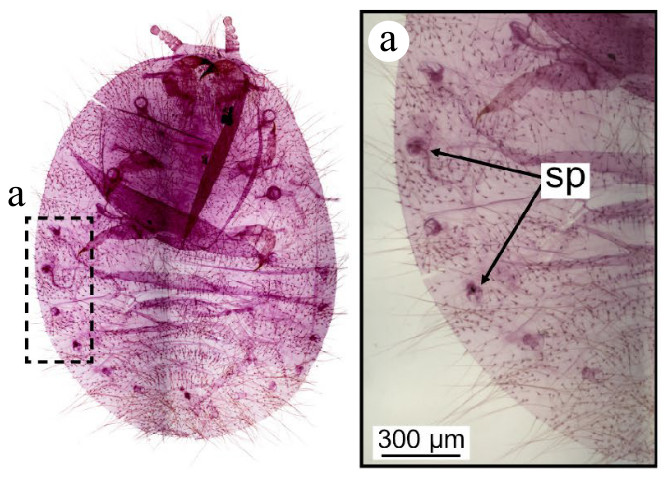Valid Names Results
Eurhizococcus colombianus Jakubski, 1965 (Margarodidae: Eurhizococcus)Nomenclatural History
- Eurhizococcus brasiliensis; Figueroa Potes 1946: 216. misidentification (discovered by Jakubs1965, 179).
- Eurhizococcus colombianus Jakubski 1965: 179. Type data: COLOMBIA: Rionegro, on roots of raspberry, 13.xi.1944, E.J. Hambleton.. Holotype, female, Type depository: Washington: United States National Entomological Collection, U.S. National Museum of Natural History, District of Columbia, USA; accepted valid name
- Eurhizococcus silvestri Jakubski 1965: 181. nomen nudum (discovered by Jakubs1965, 181).
Common Names
- Colombian ground pearl GillChFo2022
- Perla de tierra de Colombia GillChFo2022
Ecological Associates
Hosts:
Families: 4 | Genera: 4
- Apiaceae
- Arracacia xanthorrhiza | Jakubs1965
- Lauraceae
- Persea americana | KondoMu2016
- Rosaceae
- Rubus | EfromBoDe2012 Jakubs1965
- Vitaceae
- Vitis labrusca | KondoGo2008
Foes:
Families: 1 | Genera: 1
- Steinernematidae
- Steinernema colombiense | RodrigDa2024
Geographic Distribution
Countries: 1
- Colombia | Jakubs1965 KondoGo2008
Keys
- CaballKo2024: pp.2 ( Adult (F) ) [Species associated with coffee roots in Colombia]
- daSilvCa2012: pp.212 ( Adult (F) ) [Key to the species of Termitococcinae]
- daSilvCa2012: pp.212 ( First instar ) [Key to the species of Termitococcinae]
- KondoGo2008: pp.36 ( Adult (F) ) [species of Eurhizococcus]
Remarks
- Systematics: Eurhizococcus colombianus is similar to E. brasiliensis, but adult females of these species can be separated by the number of antennal segments: 6 in E. colombianus but only 5 in E. brasiliensis. First-instar nymphs of E. colombianus have 2-segmented antennae, whereas those of E. brasiliensis have 1-segmented antennae. In the cyst stages of E. colombianus the abdominal spiracles are associated with perispiracular pores, whereas in cysts of E. brasiliensis there are no perispiracular pores associated with the abdominal spiracles. (Foldi, Watson & Kondo in T. Kondo & G. Watson, 2022)
- Structure: The adult females and males visit the soil surface for mating. Live adult female covered with very long fine hairs, body 6.5–9.5 mm long, pale yellow. Eggs, crawlers and immature cysts whitish to pale yellow. (Foldi, Watson & Kondo in T. Kondo & G. Watson, 2022)
- Biology: Found on roots of the host plants (Jakubski, 1965). Kondo & Gomez (2008) found that this scale insect is inducing gall formation on roots of grapevines.
- Economic Importance: Kondo & Gomez (2008) reported this species as a new pest of grapevines, Vitis labrusca L. in Valle del Cauca, Colombia. Brief notes on the biology and morphology of E. colombianus are given, and the induction of an insect gall by a ground pearl is for the first time reported. A key to separate the two known species of Eurhizococcus is provided. This is the first record of this species on grapevines.
- General Remarks: Description of adult female and nymphs by Jakubski (1965). Description and illustration of the adult female by The morphology of the insect is compared with E. brasiliensis (Wille), a species known as an important pest of grapevines in Brazil, and the only other species included in the genus Eurhizococcus Silvestri.
Illustrations
Citations
- BenDov2005a: catalog, distribution, host, taxonomy, 53
- CaballKo2024: illustration, key, morphology, 2
- CortesIgMo2024: biology, 5
- EfromBoDe2012: distribution, host, 1546
- Figuer1946: distribution, host, taxonomy, 216
- Foldi2001a: taxonomy, 201
- GillChFo2022: biology, control, diagnosis, distribution, economic importance, host, illustration, 67-68
- Jakubs1965: description, distribution, host, taxonomy, 179-181
- Kondo2019: distribution, 128
- KondoGo2008: description, distribution, economic importance, host, taxonomy, 34-40
- KondoMu2016: distribution, host, illustration, 13
- KondoWa2022a: distribution, host, list, 21
- KondoWa2022d: illustration, 549
- QuinonViTo2008: chemistry, morphology, taxonomy, 190-194
- RodrigDa2024: biological control, natural enemies, 318
- daSilvCa2012: description, distribution, illustration, taxonomy, 316-319




